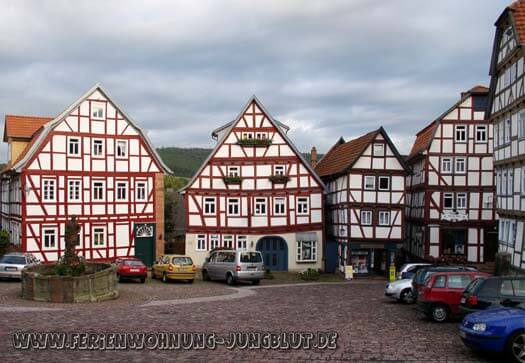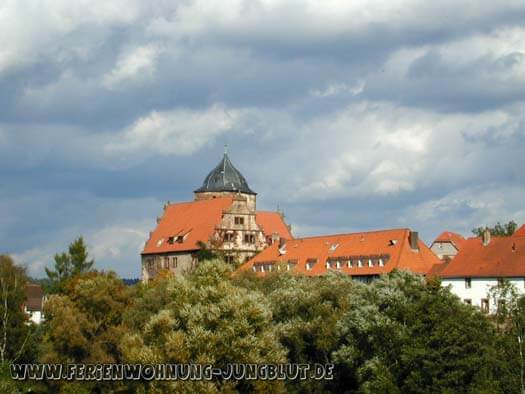Schlitz
A view from the windows of our apartment shows the medieval market square, paved with old sand stone, a ring of handsome half-timbered houses, in the middle the big market fountain, surmounted by St. George the Dragon Slayer, called „Bornschorsch“ („Born“ meaning fountain, „Schorsch“ meaning George) by the locals. And the Ottoburg, a castlelike building from the 17th century.

Directly behind the house: the Hinterburg, a Renaissance building connected to the Hinterturm, a medieval, 30m high castle keep, that guarded f the city for centuries. Nowadays, an elevator brings visitors to the top platform, from which you can enjoy a fantastic panoramic view of the seven mountains, which are grouped around the city: Templeberg, Antoniusberg, Steinberg, Eisenberg, Wendtberg, Wolfersberg and Sängersberg.
A few steps further, on the highest point, the gothic Stadtkirche, a Lutheran-Evangelical church since 1563, invites you to church services every Sunday or to just visit the beautifully restored interior with numerous count’s graves and plaques and the must-see baptismal font on any other day.
Just around the corner a wide gate entrance opens a view through the city walls onto the Vorderburg, a huge, strikingly beautifuly proportioned Renaissance sandstone building dating from the 16th century. In the courtyard an impressive historical draw well surrounded and guarded by massive black oak timbers is awaiting.

The description of a great historical walking tour through our idyllic town can be found on the pages of our local newspaper (Fritz Kumpf and Dr. Volker Puthz, in German language).
Schlitzerland
The Schlitzerland with its sixteen villages is comfortably and easily explored by bicycle. The perfectly-developed bike paths lead through the floodplains of the Fulda and the Schlitz, crossing some beautiful old bridges, lead you along beech tree overgrown mountains and lakes in Pfordt or or sometimes directly into a village as in Fraurombach.
Fraurombach is known for its small Romanesque chapel with its wall paintings from the 14th century. You also should not miss the Village Museum in a beautiful half-timbered house with the tongue-twisting name of „Buisch ‚ahl Huss“, if you want to see first hand how a peasant family in Schlitzerland lived at the time of our great-grandmothers.

Continue tour: